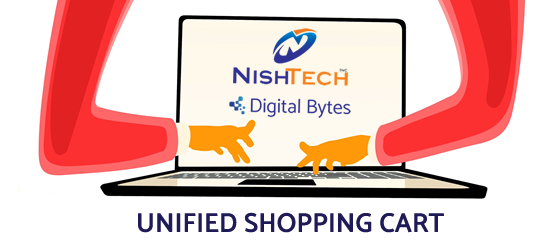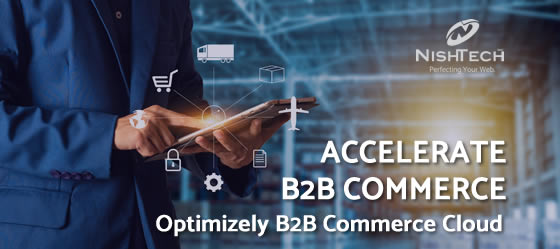Is Your Traditional B2B Ecommerce Platform Costing You Money?
written by Nishtech
|January 2023

What would you do if someone told you that your phone cost you $500 a year and there was a better option for phone service?
You’d probably go out and get a new phone. Knowing how much money you lost, you’d make back the new phone’s cost with the savings.
In the same way, you may lose money if you’re working on an old, outdated, or inefficient B2B ecommerce platform. Whether through lost sales because of customer frustration on the site, poor traffic due to a high bounce rate and SEO issues, or inefficient processes and employee frustration, your business and bottom line suffer.
The Problems with Outdated B2B Ecommerce Platforms
If you’re using an older, traditional B2B ecommerce platform, take the time to evaluate its performance. Your goal should be to estimate if the system operation is having an impact on the bottom line. Here are a few items to consider in your evaluation:
- Stagnant or Declining Revenue
Over time, if you have a good product and sales staff doing their job, you expect revenue to increase as you find and convert more customers. If you see stagnant orders or even declining revenue, then there is a problem.
Every business is different. There are market shifts and other pressures that impact orders. However, if the overall trend for your online B2B sales is decreasing, then there is a good chance that your platform is outdated or not operating as it should.
- Reduced Market and Brand Reach
Many factors go into your SERP (Search Engine Results Page) ranking. A good rule of thumb is the higher the rank on the SERP, the more customers will click and visit your site. The more people on your site, the more revenue you can make. If a search engine struggles to crawl your site due to issues with your platform, you will drop on the SERP. Fewer people will see you in search rankings, and your brand reach will suffer.
Your market and brand reach will also suffer if your bounce rate is high. When people come to your site and immediately leave because they are frustrated with site design or operation, search engines will see this as a problem. This will cause you to appear in fewer searches and hurt your brand reach and sales.
- Increased Customer Service Calls
When frustrated with a product or service, what’s the first thing some customers do? They call customer service. They ask for help, ask questions, or look for another avenue to get what they want. For your B2B ecommerce site, this could mean an increase in calls to customer service.
Most companies will track and catalog customer service calls and inquiries. The problem is that the issue with the ecommerce site might be buried in another complaint. For example, a late delivery could mean an order wasn’t pushed out of the platform. Or a wrong delivery could be a poor integration with the PIM. However, an increase in calls could mean ecommerce platform issues.
- Inefficient Internal Operations
When a system like an ecommerce platform doesn’t provide the functionality a business needs, other resources will need to compensate. For example, an employee may need to compile reports manually or print orders on a spreadsheet to type them into the ERP. This inefficiency is costing the business money.
Take a moment to examine the internal processes connected to the B2B ecommerce platform. Identify the impediments or roadblocks in getting work done related to B2B ecommerce. Often, companies will discover that poor integration or overcoming a broken component of the software is causing costly internal inefficiency.
- Poor Data Security
Data security is critical for modern business. Your customers trust you with their information. A data breach will cause customers to look for a more trustworthy vendor, and it can put you at legal risk. Don’t wait for a breach to happen. Make sure your platform is still supported and receiving security updates.
Also, consider how secure the platform is overall. No ecommerce platform is 100% secure. There is always a risk, however small, of data being stolen. However, some platforms are more secure, modern, and difficult to break into. Make sure your platform is as secure as possible.
- Increased Operation Cost
Running a traditional platform requires responsibility for all aspects of the operation, including hosting, feature development, security compliance, and upgrades. It also slows down the update frequency introduces unnecessary risk for mistakes which could cause downtime. This requires resources that could be better directed to other parts of the business.
Stop Bleeding Profit!
Simply put, you will likely lose profit and revenue if you aren’t updating your B2B ecommerce platform with the latest releases. That old, outdated platform is costing you money.
Luckily, you do have options when it comes to updating or replacing your B2B platform:
- B2B Ecommerce Platforms in the Cloud (Saas)
For many businesses, a cloud-based Software as a Service (Saas) platform for B2B ecommerce is the right choice. These platforms offer many advantages, including faster implementation time, lower overall operation cost, managed hosting and security, and faster access to new features and functionality. They are an attractive option for small businesses that don’t have large product catalogs, large IT staff, or extensive back-office operations.
These platforms also have their drawbacks: in general, they’re not as easy to customize, they don’t provide robust content management capabilities, they may not contain all the common features you would expect or need, and they usually put you at the mercy of the vendor on the timing of platform and feature upgrades.
- Headless Ecommerce Platforms
A headless ecommerce platform is one where the user interface (or front-end) is de-coupled from the data storage and core functionality (back-end). Back-end functionality is exposed through APIs and provide businesses with the flexibility to develop their own front-end components or pick and choose commercially available front-end services. Because these operations are separated, the platform is future-proof as businesses can easily switch out services as business needs or technology changes.
Additionally, headless ecommerce platforms allow companies to provide advanced personalized experiences at scale through integration of a content management system. In doing this, marketers gain more control over the type of content they deliver for each audience.
Headless is not the right approach for all companies. Implementing a headless platform comes with complexities depending on the architecture and structure of existing systems. Unlike traditional B2B ecommerce platforms there is no standard way of designing a headless solution, so the up-front implementation cost is higher.
The First Step Toward a Better B2B Ecommerce Platform
Remember, the cost of that poorly performing ecommerce platform will accumulate. Putting off an upgrade project will mean additional lost revenue and potentially more lost long-term business. The faster you can evaluate the functionality and effectiveness of your platform, the more quickly you can implement a solution.
If you have questions or want help in evaluating your software platform, then contact our ecommerce experts. We’ve been helping B2B companies solve their most challenging digital problems, and we understand how to turn a solution into additional revenue.
We’re ready to help.



